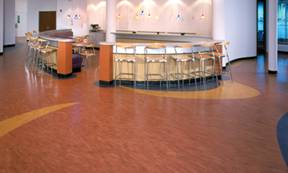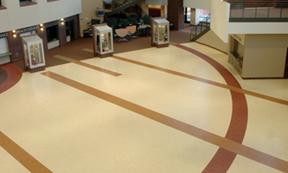What Is Linoleum?
Linoleum was invented in England in 1863 by Frederick Walton who coined the name linoleum from the Latin name, linum , which means flax, and oleum , which means oil. Later in the century, Michael Nairn, a flooring manufacturer in Kirkcaldy, Scotland perfected the flooring, introducing qualities such as inlaid patterning — a feature seen today.
Linoleum is a flooring that is manufactured by oxidizing linseed oil to form a thick mixture called linoleum cement. The cement is cooled and mixed with pine resin, and wood flour to form sheets on a jute backing. The term, linoleum is often used incorrectly to describe any sheet flooring, when in fact flooring can be made from other materials such as polyvinyl chloride.
The First Choice for the Environment
Linoleum flooring is based on a century-old recipe that features linseed oil (the oil in flax). While exhibiting all the craftsmanship of old, present-day linoleum flooring is produced in ultra-modern facilities in the European Union. For environmental reasons, linoleum is often architects’ first choice for flooring.

Linoleum shows superiority where environment plays a large part in the choice of flooring; you’ll find linoleum in prestigious educational facilities, in hospitals and government buildings all over the world.
Architects choose linoleum because it satisfies clients’ needs to be environmentally responsible. In life cycle assessments of products that deal with factors like toxicity and the depletion of natural resources, linoleum’s environmental “footprint” is small. As a result, linoleum brands, such as the Artoleum™ and Marmoleum™ made by Forbo, have earned environmental certification from the countries of Austria, Australia, Germany, the Netherlands, New Zealand and Scandinavia.
Natural ingredients

Three factors make linoleum friendly to the environment: linoleum is made of sustainable, natural ingredients; it lasts a very long time; and it disposes well.
Environmental tests on linoleum have been conducted, production processes mechanized, and factories modernized. Through it all, linseed oil from Canadian flax remains the main ingredient. Linseed oil, hardened onto the canvas of sailcloth, was the prototype for the first linoleum flooring in the 1800s and linseed oil remains as the key ingredient of new formulations for linoleum. This ingredient has not changed over time because of linseed oil’s unique properties. Linseed hardens upon exposure to the air, making it a natural coating material. Linoleum floors last for 20 years or more.
Because flax is an annual crop of the western Canadian prairies, the source of linseed oil will never be depleted. The same cannot be said for finite oil resources from which other types of sheet flooring are manufactured.
- Linseed oil (from flax)
- Rosins, tapped from pine trees
- Wood flour, ground from forest timbers
- Limestone
- Natural pigments
Easy Disposal
When discarded, linoleum flooring decomposes well in landfill sites. Linoleum is biodegradable and does not release harmful gases or toxins into the air as it breaks down.

Rooted in the past, manufactured in “high-tech” production environments, and designed for the future— linoleum is an ideal flooring for today’s world.



